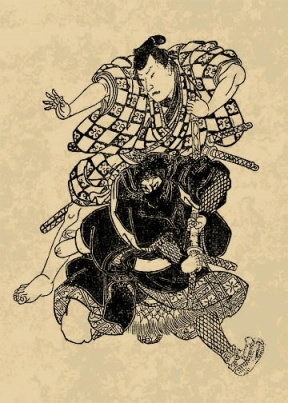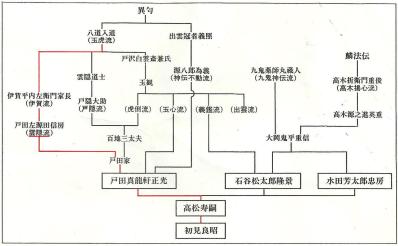From Wanderings in Budo by bujinshugyo
雲隠流忍法
伊賀流忍法の始祖といわれる伊賀平内左衛門家長(雲隠法師)の流れを組み、戸田左源田信房を経て、戸田家に伝られる。
Kumogakure ryū ninpō
Iga Heinaizaeimon Ienage (Kumogakure Hōshi) is said to be the founder of Iga ryū ninpō, this flow was brought together by Toda Sagenta Nobufusa and thereafter transmitted to the Toda family.
雲隠 Kumogakure – hiding in the clouds, hidden cloud, cloud hiding
法師 Hōshi – Buddhist priest
平内左衛門 Heinaizaeimon – peaceful house on the left side of the defensive gate
家長 Ienage – family head, patriarch
信房 Nobufusa – trusted house, faithful follower
Another descendant of Hachidō Nyūdō’s Gyokko ryū, Kumogakure ryū is seen as the creation of Toda Sagenta Nobufusa based on the Iga ryū of Iga Heinaizaeimon Ienage. Through the Toda family it then finds its way to Takamatsu Toshitusgu and Hatsumi Masaaki.
Iga Heinaizaeimon Ienage – looking at this name you can see ‘the patriarch of the family that resided in the peaceful house to the the left of the gate in Iga’ and so indicates a person of prominent position. He is also referred to as Kumogakure Hōshi, or a Buddhist priest hidden in the clouds, as noted with Togakure ryū this links the person with the nature of the Iga region and mountain asceticism. So is the style named by Toda Sagenta Nobufusa (the trusted follower) as Kumogakure ryū the taking of his teachers name or named after the location associated with the person?

The description for Kumogakure ryū is brief and the same is true for the two following styles, Gyokushin ryū and Gikan ryū. To reiterate my purpose here is just to present a translation of the text and some comments on the names/kanji, I am trying to avoid any interpretation, explanation or information based on my experience of training with Soke or the Shihan in Japan (though I had to remind myself not to add a load on Kotō ryū from Senō-sensei last time…).







